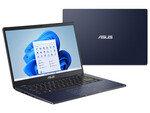Asus Vivobook Go 14X E410MA-EB1272WS
Spécifications de l'ordinateur portable

Price comparison
Moyenne de 1 notes (à partir de 3 critiques)
Critiques pour le/la Asus Vivobook Go 14X E410MA-EB1272WS
Source: 91mobiles
 EN→FR
EN→FRThe ASUS Vivobook Go 14 is a competent, budget-friendly laptop that caters to users with basic computing needs. It excels in providing essential functionality at an extremely competitive price point, making it an attractive option for consumers seeking a secondary device, or anyone operating on a tight budget. Apart from that, the combination of a decent build quality, a comfortable keyboard, and sufficient port selection makes it a practical choice for everyday use. However, those who can stretch their budget might find better performance in slightly higher-priced alternatives with more powerful processors. It’s important to weigh the pros and cons based on your specific needs. If you require a laptop for basic tasks such as web browsing, document editing, and media consumption, the Vivobook Go 14 is an excellent choice. However, for more demanding applications, investing in a higher-end model might be worthwhile.
Critique simple, disponibles en ligne, De taille moyenne, Date: 07/30/2024
Notes: Note globale: 70%
Source: Laptop Media
 EN→FR
EN→FRFrom its plastic shell to its poor performance, and not very good battery life. The ASUS E410 is a laptop that is built on the promises of compromises. You get this, but we take away that. This is where a bigger question comes in – do you really need a laptop? Are you willing to sacrifice your sanity to use the E410? Well, we are joking (of course). But really, if you want to remain intact, go for the Pentium iterations. Windows 11 really sucks on two cores. ASUS E410’s TN panel has a Full HD resolution. Its backlight doesn’t use PWM, while the pixel response times are really fast. On the other hand, the screen has very narrow viewing angles, a low contrast ratio, and limited color coverage (53% of sRGB). This makes the overall viewing experience pretty poor. This leads us to the other options – a 768p TN unit, which should be banned with a decree by the Pope, and a 1080p IPS panel. The latter is the choice you want to make, regardless of the price. Thankfully, ASUS has given you one M.2 PCIe lot to play with. We are not sure if the slot will persist, should you get an eMMC flash storage upon purchase. However, it is still good to see one. Plus, it supports NVMe drives! Expectedly, the port selection is not great – you lack an SD card slot, and one of the USB Type-As is 2.0. However, we’ve seen worse. So, would we recommend this product? Well, no. We wouldn’t. But honestly, there is nothing in this class that we would rather push you towards. Instead, if you really don’t have the budget for something better, make sure you get two things – a Pentium CPU, and an IPS panel. The other stuff is not that bad.
Critique simple, disponibles en ligne, Très longue, Date: 04/12/2023
Source: Techrush.de
 DE→FR
DE→FRCritique simple, disponibles en ligne, Longue, Date: 07/14/2022
Commentaire
Intel UHD Graphics (Jasper Lake 16 EU):
Carte graphique intégrée dans les modèles d'entrée de gamme Intel Jasper Lake Celeron basés sur l'architecture Gen. 11. Offre 16 des 32 UE (Unités d'exécution / Shader Cluster). La fréquence d'horloge dépend du modèle de processeur, allant de 350 MHz en base à 800 MHz en boost. Les puces Jasper Lake sont produites selon le processus 10nm chez Intel (similaire à Ice Lake).
La plupart des jeux pas trop demandants actuels peuvent tourner de façon fluide. soyez prêts à endurer un rendu graphique assez moche à cause de la basse résolution et des détails au minimum. Par ailleurs ces cartes sont suffisantes pour un travail de bureau et le visionnage de vidéos (pas évident pour la vidéo HD).
>> Plus d'informations sont à trouver dans notre comparaison des cartes graphiques mobiles et ainsi que dans notre liste des Benchmarks affiliés.
Celeron N4500:
SoC double cœur à faible consommation de la série Jasper Lake pour les ordinateurs portables bon marché. Il fonctionne avec des horloges comprises entre 1,1 et 2,8 GHz et intègre une carte graphique compatible DirectX 12 avec 16 UE et jusqu'à 750 MHz. Les cœurs du processeur sont plus petits et plus lents que dans les processeurs Core (par exemple Ice Lake) mais fabriqués dans le même processus 10nm.
>> Plus d'informations sont à trouver dans notre comparaison des processeurs mobiles.



